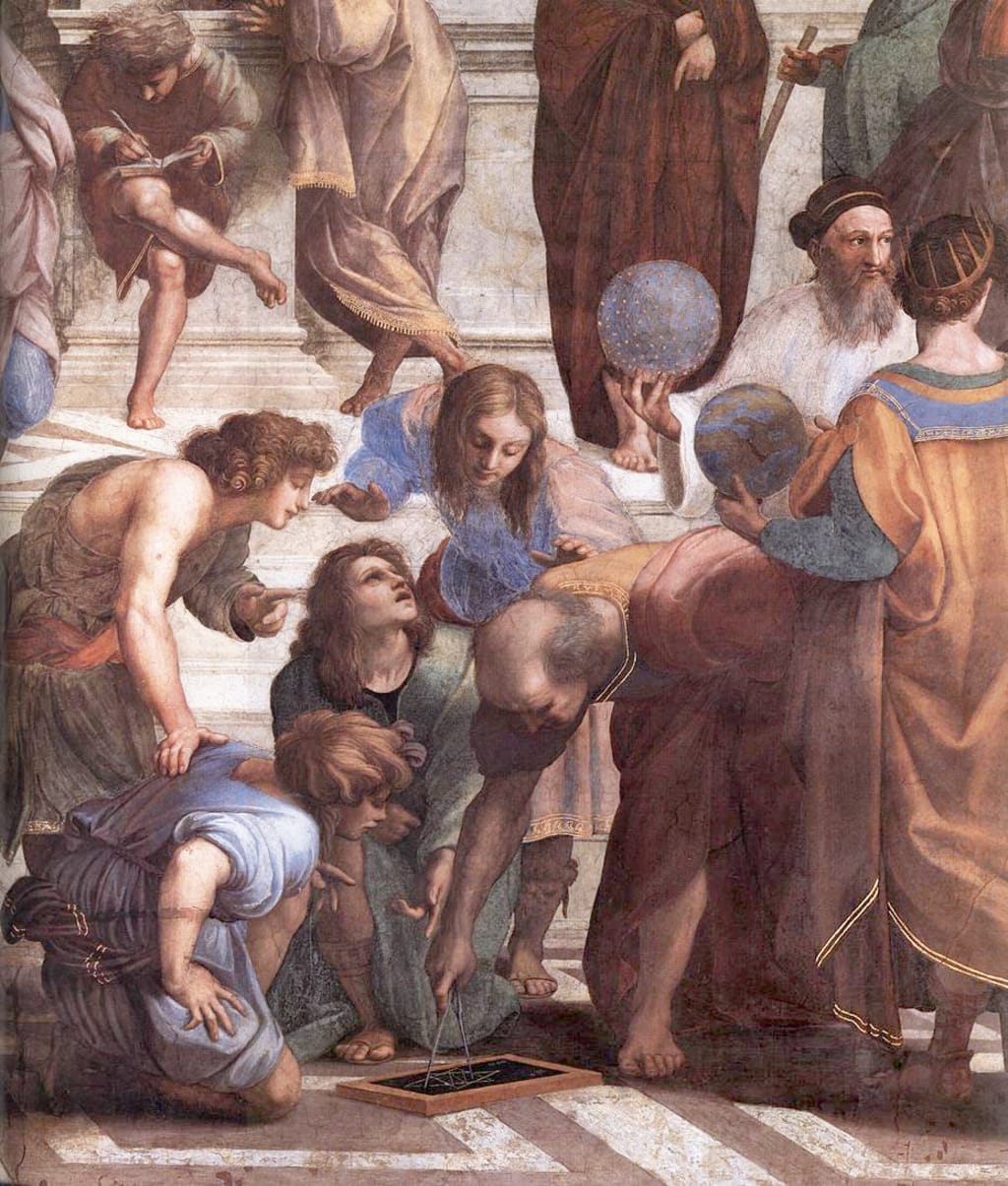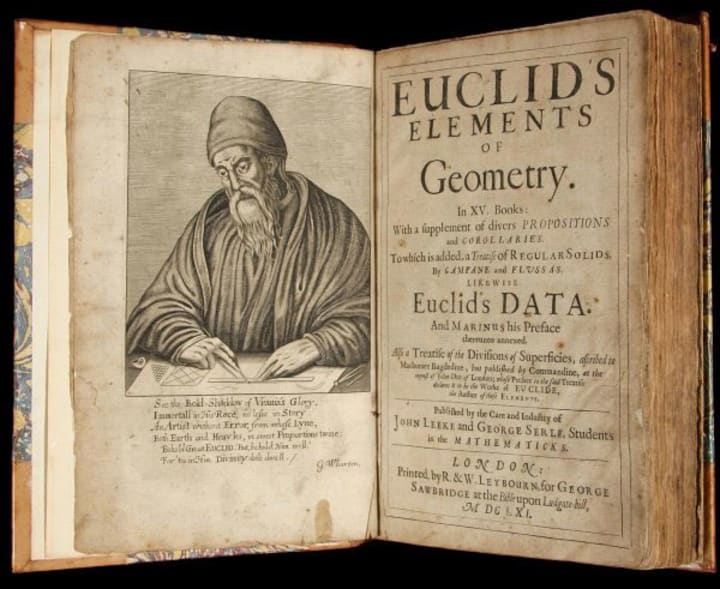Euclid of Alexandria — The Man Behind The Evolution Of Geometry
Author of a phenomenal treatise “The Elements”

History
Euclid is an English name means “renowned and glorious”, that is certainly a reflection of his personality. He was a famous mathematician, born in Alexandria, Egypt around 365 B.C and was known as the founding father of geometry. He obtained much of his insightful knowledge from Plato’s students in Athens, Greece.
A little is known about his personal life apart from an influential set of books he assembled. His most famous work includes the collection of his 13 volumes treatise, dealing with geometry, named ‘The Elements’. Though many of the written work was taken and categorized from the teachings of early mathematicians. As a matter of fact, he created a sagacious source that could easily be referenced and quoted.
Among them 1–6 involve the geometry of planes, 7–9 include number theory, 10 deals with Eudoxus’s theory of irrational numbers, and 11–13 involve solid geometry. These books disclosed the philosophy behind mathematics and proved the system of fundamental theorems that are foundations of mathematics to date.
Moreover, these books immensely influenced the work of mathematicians like Johannes Kepler, Nicolaus Copernicus, Galileo Galilei, and Sir Issac Newton. Similarly, some philosophers like Alfred North Whitehead, Baruch Spinoza, and Bertrand Russell also benefited from The Elements in their respective disciplines.
They are known to be The most studied books apart from the Bible. These spectacular textbooks guided the whole world’s perception and for generations to come. Euclid once quoted about the importance of geometry and mathematics as,
“The laws of nature are but the mathematical thoughts of God” ~ by Euclid of Alexandria
The above statement highlights something very fundamental about nature that the math governs all the laws of the Universe.

Euclidean geometry
The word geometry has been derived from a Greek word geo-metron which means to measure the earth. Euclidean geometry is the study of points, line segments, planes, and other measurable objects without the use of coordinates.
Once, the ruler Ptolemy asked Euclid if there is a shorter way to learn about geometry apart from going through The Elements. He received a reply
“There is no royal road to geometry.”
Now I would like to mention the most significant section of The Elements involving a discussion about the fifth postulate or the parallel postulate. In the first volume, he listed five postulates among which the fifth one attracted the noteworthy attention which states as,
If a straight line falling on two straight lines makes the interior angles on the same side of it taken together less than two right angles, then the two straight lines, if produced indefinitely, meet on that side on which the sum of angles is less than two right angles.

The postulate took a long and glorious history because of its awkwardness. In comparison, the other four postulates were somehow self-evident and obvious. Many mathematicians attempted to prove the above statement and even presented the equivalent axioms.
Nasir al-Din al-Tusi — a Persian polymath and Girolamo Saccheri — an Italian philosopher and mathematician tried to prove the postulate by the reductio ad absurdum (argument negation) method.
Later a Russian mathematician Nikolai Lobachevsky and the Hungarian mathematician János Bolyai noticed independently that another form of geometry (elliptic, hyperbolic, or spherical) could be created which assumes some other form of the fifth postulate.
Afterall, Bernhard Riemann and Henri Poincaré were successful in developing that prime geometry which is now known as the Riemannian or non-Euclidean geometry. Hence by the end of the last century, it was manifested once, and for all that, the parallel postulate is independent of the remaining four postulates.
The prominence of The Elements
The 16th US president — Abraham Lincon used to keep a copy of The Elements in his saddlebag and studied it till late night by the lamplight, while he was working as a traveling lawyer. He was acclaimed of using Euclidean logic-based analysis and arguments in his law practice or legal cases. The beauty of Euclidean geometry has been perceived by many western people as a sight of conviction and excellence. Abraham Lincon quoted:
“In the course of my law reading, I constantly came upon the word demonstrate. I thought at first that I understood its meaning but soon became satisfied that I did not. I said to myself, What do I do when I demonstrate more than when I reason or prove? How does demonstration differ from any other proof? I consulted Webster’s Dictionary. They told of ‘certain proof,’ ‘proof beyond the possibility of doubt’; but I could form no idea of what sort of proof that was. I thought a great many things were proved beyond the possibility of doubt, without recourse to any such extraordinary process of reasoning as I understood the demonstration to be. I consulted all the dictionaries and books of reference I could find, but with no better results. You might as well have defined blue to a blind man. At last, I said,- Lincoln, you never can make a lawyer if you do not understand what demonstrate means; and I left my situation in Springfield, went home to my father’s house, and stayed there till I could give any proposition in the six books of Euclid at sight. I then found out what demonstrate means, and went back to my law studies.”
Lincoln more or less mastered the 6 volumes of The Elements after carefully working out the Euclidean axioms and propositions, which improved his power on logic and language. He was always fascinated by logic and mathematics that fairly reflected in his writings and speeches.
Albert Einstein confessed about the “holy little geometry book —The Elements” and the magnetic compass as two important benefactions that influenced him greatly when he was a boy.
The ultimate success of this book is predominantly due to the logical portrayal of all the available knowledge concerning geometry at that time. A systematic walk through a small set of axioms to extensive results and the consistency of his analytical reasoning over the whole book motivated its use as a textbook for about 2000 years.
About the Creator
Areeba Merriam
Research student | MS mathematics
Pursuing my research in the field of general relativity.
As a hobby I write blogs about popular science topics and biographies of scientists.






Comments
There are no comments for this story
Be the first to respond and start the conversation.